San Marco Evangelista al Campidoglio, Rome
| San Marco Evangelista Basilica | |
|---|---|
Basilica di San Marco Evangelista al Campidoglio (Italian) | |
 South façade of the basilica. To the right, Palazzo Venezia, the former embassy of the Republic of Venice, whose protector was St. Mark. | |
Click on the map for a fullscreen view | |
| 41°53′44.6″N 12°28′53.2″E / 41.895722°N 12.481444°E | |
| Location | Piazza di S. Marco 48, Rome, Italy |
| Denomination | Latin Catholic |
| Website | www |
| History | |
| Dedication | Mark the Evangelist |
| Consecrated | AD 324 |
| Clergy | |
| Cardinal protector | Angelo De Donatis |
San Marco is a titular basilica in Rome dedicated to Saint Mark the Evangelist, located in the small Piazza di San Marco adjoining Piazza Venezia. It was first consecrated in 336 by Pope Mark and rebuilt in its present form in 833 by Pope Gregory IV. Today, the basilica is the national church of Venice in Rome.
History
Earlier buildings
According to the Liber pontificalis, Pope Mark established a basilica in a place called ad Pallacinas in 336.[1] This first church was built atop preexisting, pre-Constantinian structures of unknown date or function, but excavations in the mid-20th century revealed a surviving ancient Roman mosaic with acanthus vine-scroll ornamentation underneath the present-day basilica's right aisle.[2] Pope Mark's first church incorporated walls from this earlier structure, and featured a new colonnade, opus sectile pavements, and frescoed walls, of which a small fragment depicting several horses survives underneath the present-day basilica.[2] The synod of Pope Symmachus in 499 records the church as Titulus Marci.[3] It is likely that the previous ancient Roman structure was initially a residence owned by Pope Mark, who then gifted the property to a Christian congregation within the first few months of his papacy.[2] Archaeological excavations further revealed burned marble and ash deposits on the pavement, which provide evidence that the first church was likely destroyed in a fire.[2]
A second church was built possibly in the second half of the 6th century, but the lack of archaeological evidence and written records make it difficult to properly date. The floor was placed one meter above the first church's floor, possibly to protect the structure against flooding, which was common in medieval Rome. This second church followed the first church's floor plan, only with the addition of a chancel enclosure that divided the nave and provided space for the Schola Cantorum.[2] The Liber pontificalis notes that Pope Adrian I made repairs to the second church's roof and aisles, and provided the basilica with altar cloths, curtains, and seven gold chalices.[4]
Present-day basilica
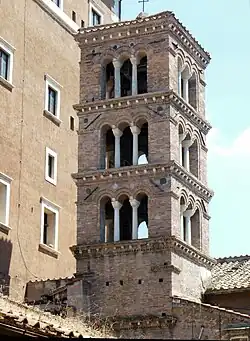


According to the Liber pontificalis, Pope Gregory IV saw the ruinous state of the second church and decided to have it demolished in 833 to rebuild the basilica now seen today.[5] The new church's floorplan also aligns with the prior churches, with two aisles flanking a nave that terminates in an apse. The floor consists of large blocks of tufa that were likely part of the Servian walls. Gregory IV's unique contributions to this rebuilding was the monumental apse mosaic, the annular crypt, and the clerestory.[6]
The apse mosaic is the best surviving element of the Gregory IV's resconstruction in 833. It depicts Jesus in the center with Pope Mark, St. Agapetus, and St. Agnes to his left and St. Feliccissimus, Gregory IV, and St. Mark the Evangelist to his right. All seven figures stand against a solid golden backdrop standing atop pedestals with inscriptions identifying the figures. Below the figures, twelve lambs representing the Twelve Tribes of Israel, lead out of Bethlehem and Jerusalem and surround the Lamb of God. On the apsidal arch, St. Peter and St. Paul stand beneath the roundels of Christ and the Four Evangelists. The Latin dedicatory inscription running along the bottom of the apse mosaic reads:
VASTA THOLI FIRMO SISTVNT FVNDAMINE FVLCHRA / QVAE SALOMONIACO FVLGENT SVB SIDERE RITV / HAEC TIBI PROQVE TVO PERFECIT PRAESVL HONORE / GREGORIS MARCE EXIMIO CVI NOMINE QUARTVS / TV QVOQVE POSCE DEVM VIVENDI TEMPORA LONGA DONET / ET AD CAELI POST FVNVS SIDERA DVCAT.
English translation:
The huge supports of the apse, which shine like Solomon's temple beneath the stars, rests on a solid foundation. These things, O Mark, the pope with the distinguished name of Gregory IV has made for you and in your own honor. And you pray that God may grant him a long life on earth and after death lead him to the stars of heaven.[7]
The choice to position Mark the Evangelist in the composition in the place traditionally reserved for St. Peter appears to be an intentional subversion of established apse mosaics depicting groups of saints with the donor pope. Art historian Claudia Bolgia suggests that the translation of Mark's relics from Alexandria to St. Mark's Basilica in Venice in 830–31 had an influence on Pope Gregory IV's decision to depict himself in relationship to this particular evangelist. Furthermore, the inclusion of Sts. Agapetus and Feliccissimus may refer to Gregory IV having recently sent their relics to a Bavarian monastery. Therefore, the apse mosaic evokes the spiritual presence of these saints, despite their relics physically existing outside of Rome and, therefore, the immediate jurisdiction of the Holy See.[7] While papal self-representation in apse mosaics was fairly common in the ninth century (i.e. Pope Paschal I in Santa Prassede and Santa Cecilia in Trastevere), Pope Gregory IV's inclusion in at San Marco speaks to his desire to establish papal authority in the city.[8]
Further changes were made to the church throughout the 12th century, with the addition of a Romanesque campanile above the southern end of the nave, sculptural work around the main southern portal, and a new ciborium above the high altar. From 1465–70, Pope Paul II renovated the church's façade according to the Renaissance taste, with a two-storied portico and loggia, using marbles taken from the Colosseum and the Theater of Marcellus. It was at this time that the church was incorporated into the Palazzo Venezia complex, and the clerestory windows were enlarged and ornamented with Gothic tracery, a common feature of Quattrocento Roman architecture.[2] Inside, the wooden ceiling with the emblem of Pope Paul II is one of only two original 15th-century wooden ceilings that can be seen in Rome today (the other being the ceiling at Santa Maria Maggiore). In 1564, Pope Pius IV gave the Republic of Venice control over most of Palazzo Venezia to use as its embassy, thereby making the basilica the national Venetian church in Rome.[9] During the early modern period, the church's interior underwent two major redecoration campaigns in the Baroque style. From 1654–57, Niccolò Sagredo commissioned Orazio Torriani to redecorate the colonnade with regularized Ionic capitals and white-washed shafts. Then, from 1732–54, Cardinal Angelo Maria Quirini commissioned Filippo Barigioni to redesign the high altar and choir stalls.[2] Paintings and sculptures by Baroque and Neoclassical artists, such as Pier Francesco Mola, Guillame Courtois, Palma il Giovane, Luigi Primo, Carlo Maratta, Cosimo Fancelli, and Antonio Canova can be found in throughout the nave of the present-day church.[10]
In 1843, Gregory IV's annular crypt, which had been closed in 1474 under Cardinal Marco Barbo, was rediscovered. Excavations in 1947–50 revealed the foundations and remnants of the earlier churchs, as well as a large cypress chest in the crypt that contained the relics of Pope Mark, St. Abdon and St. Sennen.
Cardinal priests
The following is a list of the past cardinal priests of San Marco, Rome:[11]
| Image | Name | Dates | Notes |
|---|---|---|---|
_Liber_Chronicarum_(serietitel)%252C_RP-P-2016-49-57-7.svg.png)
|
Gregorio | 797 – 20 December 827 | Elected Pope Gregory IV |
_Liber_Chronicarum_(serietitel)%252C_RP-P-2016-49-57-4.svg.png)
|
Adriano | 842 – 13 November 867 | Elected Pope Adrian II |
_Liber_Chronicarum_(serietitel)%252C_RP-P-2016-49-66-3.svg.png)
|
Guido di Castello | December 1113 – 26 September 1143 | Elected Pope Celestine II |

|
Rolando Bandinelli | 1151 – 7 September 1159 | Elected Pope Alexander III |
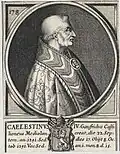
|
Goffredo Castiglione | 18 September 1227 – 1239 | Appointed Bishop of Sabina, later elected Pope Celestine IV |
.svg.png)
|
Pietro Peregrosso | 1289 – 1 August 1295 | Died |
.jpg)
|
Giovanni Gaetano Orsini | 16 September 1317 – 27 August 1335 | Died |
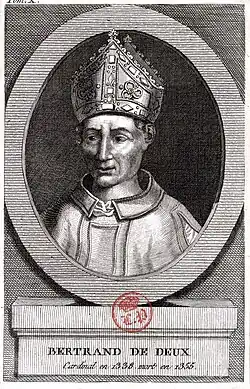
|
Bertrand de Déaulx | 18 December 1338 – 4 November 1348 | Appointed Bishop of Sabina |
| Francesco degli Atti | 23 December 1356 – 25 August 1361 | Died | |
.svg.png)
|
Jean de Blauzac (Blandiac) | 17 September 1361 – 1372 | Appointed Bishop of Sabina |
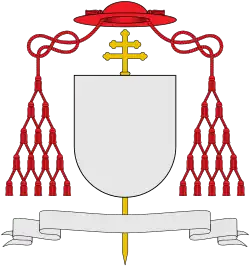
|
Pierre Amiel de Sarcenas | 18 December 1379 – 10 August 1389 | Died |
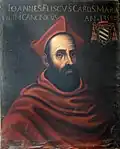
|
Giovanni Fieschi | 1390 – December 1381 | Died |
| Ludovicio Donato | 1382 – 1385 | Died | |
.jpg)
|
Angelo Correr (Corrario) | 12 June 1405 – 30 November 1406 | Elected Pope Gregory XII |
.svg.png)
|
Antonio Calvi | 2 July 1409 – 2 October 1411 | Died |
_(14781906112).jpg)
|
Guillaume Fillastre | 6 June 1411 – 6 November 1428 | Died |
| Angelotto Fosco | 19 September 1431 – 6 November 1428 | Died | |

|
Pietro Barbo | 16 June 1451 – 30 August 1464 | Elected Pope Paul II |

|
Marco Barbo | 2 October 1467 – 2 March 1491 | Died |
.svg.png)
|
Lorenzo Cibo de Mari | 14 March 1491 – 21 December 1503 | Died |
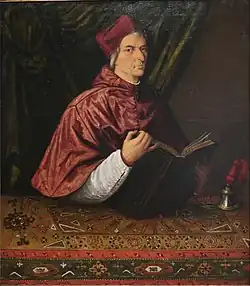
|
Domenico Grimani | 25 December 1503 – 27 August 1523 | Died |
.jpg)
|
Marco Cornaro | 14 December 1523 – 20 May 1524 | Appointed Bishop of Albano |
.jpg)
|
Francesco Pisani | 3 May 1527 – 21 June 1564 | Resigned |

|
Luigi Cornaro | 21 June 1564 – 2 June 1568 | Opted for the titulus of S. Vitale |
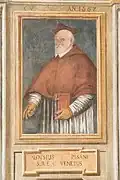
|
Luigi Pisani | 2 June 1568 – 3 June 1570 | Died |

|
Luigi Cornaro (second term) | 9 June 1570 – 10 May 1584 | Died |
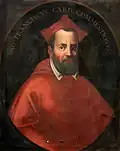
|
Giovanni Francesco Commendone | 14 May 1584 – 26 December 1584 | Died |
| Agostino Valier | 14 January 1585 – 1 June 1605 | Appointed Bishop of Palestrina | |

|
Giovanni Delfino | 1 June 1605 – 23 June 1621 | Translated to San Girolomo dei Croati |

|
Matteo Pruilli | 23 June 1621 – 13 March 1624 | Died |

|
Pietro Valier | 18 March 1624 – 9 April 1629 | Died |
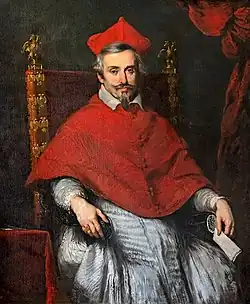
|
Federico Cornaro | 26 April 1629 – 19 November 1646 | Translated to Santa Maria in Trastevere |
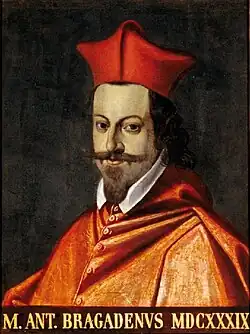
|
Marcantonio Bragadin | 19 November 1646 – 28 March 1658 | Died |
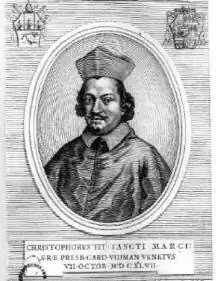
|
Cristoforo Vidman | 1 April 1658 – 30 September 1660 | Died |
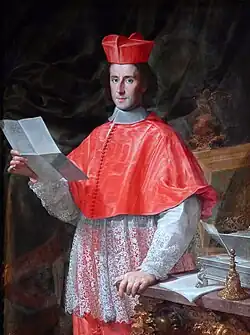
|
Pietro Ottoboni | 15 November 1660 – 13 September 1660 | Translated to Santa Maria in Trastevere |
%252C_RP-P-1909-4370.jpg)
|
Gregorio Barbarigo | 13 September 1677 – 18 June 1697 | Died |
| Marcantonio Barbarigo | 1 July 1697 – 26 May 1706 | Died | |
%252C_RP-P-1909-5583.jpg)
|
Giambattista Rubini | 25 June 1706 – 17 February 1707 | Died |

|
Giovanni Alberto Badoer | 11 July 1712 – 14 May 1714 | Died |
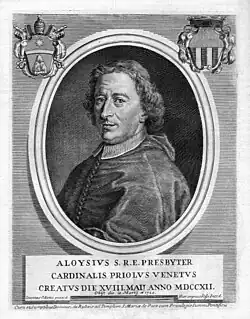
|
Luigi Priuli | 28 May 1714 – 15 March 1720 | Died |
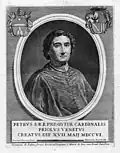
|
Pietro Priuli | 6 May 1720 – 22 January 1728 | Died |
.jpg)
|
Angelo Maria Quirini | 8 March 1728 – 6 January 1755 | Died |

|
Carlo della Torre Rezzonico | 17 February 1755 – 6 July 1758 | Elected Pope Clement XIII |
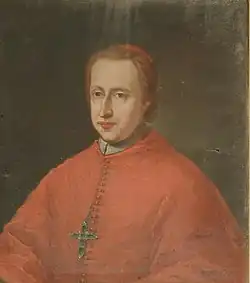
|
Antonio Maria Pruili | 19 April 1762 – 26 October 1772 | Died |
_%E2%80%93_1758.jpg)
|
Carlo Rezzonico | 14 December 1772 – 26 January 1799 | Died |
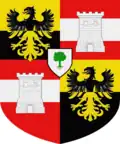
|
Ludovico Flangini Giovanelli | 2 April 1800 – 24 May 1802 | Translated to S. Anastasia |
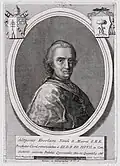
|
Luigi Ercolani | 22 July 1816 – 10 December 1825 | Died |

|
Karl Kajetan von Gaisruck | 21 May 1829 – 19 November 1846 | Died |
._Cardinal_Charles_Januarius_Edward_Acton_(1803-1847).jpg)
|
Charles Januarius Acton | Died | |
.jpg)
|
Giacomo Piccolomini | 4 October 1847 – 17 August 1861 | Died |
.svg.png)
|
Pietro de Silvestri | 27 September 1861 – 19 November 1875 | Died |
.svg.png)
|
Domenico Bartolini | 3 April 1876 – 2 October 1887 | Died |
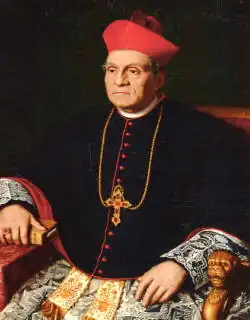
|
Michelangelo Celesia | 25 November 1887 – 14 April 1904 | Died |
| József Samassa | 11 December 1905 – 20 August 1912 | Died | |

|
Franz Xavier Nagl | 2 December 1912 – 4 February 1913 | Died |
_1927_%C2%A9_Georg_Fayer_(1891%E2%80%931950)_OeNB_10453845.jpg)
|
Friedrich Piffl | 25 May 1914 – 12 April 1932 | Died |

|
Elia Dalla Costa | 13 March 1933 – 22 December 1961 | Died |
.jpg)
|
Giovanni Urbani | 19 March 1962 – 17 September 1969 | Died |
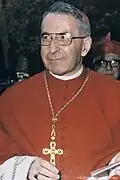
|
Albino Luciani | 5 March 1973 – 26 August 1978 | Elected Pope John Paul I |
| Marco Cé | 30 June 1979 – 12 May 2014 | Died | |
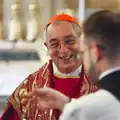
|
Angelo De Donatis | 28 June 2018 – today | Current cardinal priest |
See also
References
- ^ Loomis, Louise Ropes (1916). The Book of the Popes (Liber pontificalis), Vol. 1: To the Pontificate of Gregory I. Columbia University Press. p. 72.
- ^ a b c d e f g Krautheimer, Richard (1959). Corpus Basilicarum Christianarum Romae: The early Christian basilicas of Rome (IV-IX Cent.), Vol. 2. Vatican City: Pontificio Istituto di Archeologia Cristiana. pp. 216–247.
- ^ Kirsch, Johann Peter (1918). Die römischen Titelkirchen im Altertum. Studien zur Geschichte und Kultur des Altertums ...9. Bd., 1. und 2. Hft. Paderborn: F. Schöningh. p. 8.
- ^ Duchesne, Louis Marie Olivier (1886). Le Liber pontificalis; texte, introduction et commentaire par L. Duchesne (Volume 1). p. 500.
- ^ Duchesne, Louis Marie Olivier (1892). Le Liber pontificalis; texte, introduction et commentaire par L. Duchesne (Volume 2). pp. 74–75.
- ^ Senekovic, Darko (2020), "S. Marco", Corpus Cosmatorum, vol. 2, no. 4, pp. 47–68
- ^ a b Bolgia, Claudia (2006). "The Mosaics of Gregory IV at S. Marco, Rome: Papal Response to Venice, Byzantium, and the Carolingians". Speculum. 81 (1): 1–34. ISSN 0038-7134.
- ^ Noble, Thomas F.X. "Topography, celebration, and power: the making of a papal Rome in the eighth and ninth centuries". In Topographies of Power in the Early Middle Ages, (Leiden, The Netherlands: Brill, 2001).
- ^ Dengel, Philipp; Dvořák, Max; Egger, Hermann (1909). Der Palazzo di Venezia in Rom. Getty Research Institute. Wien : F. Malota.
- ^ Angeli, Diego (1902). Le chiese di Roma; guida storica e artistica delle basiliche, chiese e oratorii della città di Roma. Getty Research Institute. Roma, Società editrice Dante Alighieri. pp. 247–251.
- ^ "San Marco (Cardinal Titular Church) [Catholic-Hierarchy]". www.catholic-hierarchy.org. Retrieved 13 August 2025.
Further reading
- Armellini, Mariano. Le chiese di Roma, dalle loro origine sino al secolo XVI. Rome: Editrice Romana, 1887, pp. 327–329.
- Bartolini, Domenico. La sotterranea confessione della romana basilica di S. Marco, Rome: Tip. di C. Puccinelli, 1844.
- Cecchelli, Margherita. "S. Marco a Piazza Venezia: Una basilica romana del periodo Costantiniano". In Costantino il Grande: Dall'antichità all'umanesimo, vol. 1, edited by Giorgio Bonamente and Franca Fusco, pp. 299–310. Macerata, 1992. OCLC 489909697.
- Cecchelli, Margherita. "S. Marco". In Materiali e tecniche dell'edilizia paleocristiana a Roma, edited by Margherita Cecchelli, pp. 298–302. Rome, 2001. OCLC 47895754.
- Forcella, Vincenzo. Le inscrizioni della chiese e d'altri edifice di Roma, vol. 4. Rome: Tip. dei Fratelli Bencini, 1874, pp. 341–376.
- Hermanin, Federico. San Marco. Rome: Danesi, 1932. OCLC 1700751.
- Oakeshott, Walter. The Mosaics of Rome: From the Third to the Fourteenth Centuries. Greenwich, CT: New York Graphic Society, 1967. OCLC 276137.
External links
- Basilica of San Marco Evangelista at the Campidoglio. Turismo Roma. Accessed April 8, 2025. (In English)
| Preceded by Santa Maria Ausiliatrice, Rome |
Landmarks of Rome San Marco Evangelista al Campidoglio, Rome |
Succeeded by Santa Maria degli Angeli e dei Martiri |